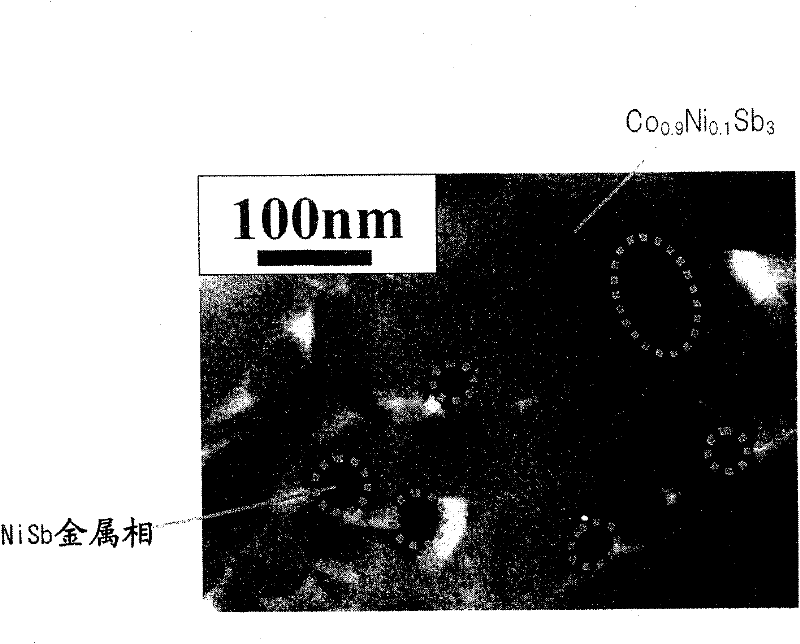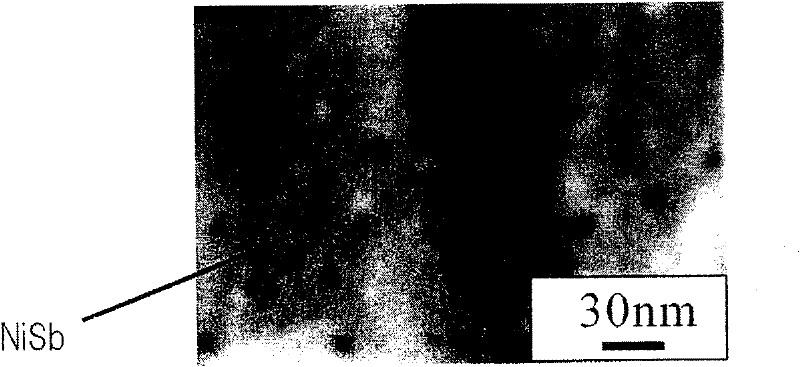Thermoelectric conversion element, and method for production thereof
A technology of thermoelectric conversion and thermoelectric conversion materials, which is applied in the manufacture/processing of thermoelectric devices, materials for junction leads of thermoelectric devices, transportation and packaging, etc. It can solve the problems of thermal conductivity κ increase, effective mass reduction, Seebeck coefficient α Reduce and other problems, to achieve the effect of performance index ZT improvement and performance improvement
- Summary
- Abstract
- Description
- Claims
- Application Information
AI Technical Summary
Problems solved by technology
Method used
Image
Examples
Embodiment 1
[0066] 2.0 g of sodium borohydride as a reducing agent was mixed with 100 mL of ethanol. On the other hand, 0.9 g of cobalt chloride, 3.6 g of antimony chloride, and 0.18 g of nickel chloride were mixed with 100 mL of ethanol, and the solution was added dropwise to the above-mentioned sodium borohydride solution. The cobalt, antimony and nickel particles thus formed were washed with a mixed solution of ethanol and water (mixing ratio 1:1) to remove impurities.
[0067] The obtained slurry containing cobalt, antimony, and nickel particles was hydrothermally treated at 240° C. for 24 hours. At this time, due to the excessive presence of nickel and antimony, the target thermoelectric conversion material Co 0.9 Ni 0.1 Sb 3 Since it exists in an amount above the solid solution limit, it precipitates as NiSb in the thermoelectric conversion material. Then, the thermoelectric conversion element of the present invention was obtained by SPS sintering at 500°C. Figure 5 A TEM imag...
Embodiment 2
[0074] 0.7 g of sodium borohydride as a reducing agent was mixed with 100 mL of ethanol. On the other hand, 0.8 g of nickel chloride and 0.77 g of antimony chloride were mixed with 100 mL of ethanol, and this solution was added dropwise to the above-mentioned sodium borohydride solution. In this way, nickel-antimony particles were produced, and the NiSb alloy particles having an average particle diameter of 10 to 20 nm were obtained by hydrothermal treatment at 240° C. for 24 hours. 0.6 g of this NiSb alloy particle was added to 100 mL of ethanol, and 1.7 g of sodium borohydride was further added.
[0075] 0.9 g of cobalt chloride, 2.7 g of antimony chloride, and 0.057 g of nickel chloride were mixed in 100 mL of ethanol, and the solution was added dropwise to the above-mentioned NiSb alloy-containing ethanol solution. In this way, Co, Ni and Sb particles are precipitated around the NiSb alloy. Then, by performing hydrothermal treatment at 240° C. for 24 hours, composite par...
PUM
| Property | Measurement | Unit |
|---|---|---|
| particle diameter | aaaaa | aaaaa |
| particle diameter | aaaaa | aaaaa |
Abstract
Description
Claims
Application Information
 Login to View More
Login to View More - R&D
- Intellectual Property
- Life Sciences
- Materials
- Tech Scout
- Unparalleled Data Quality
- Higher Quality Content
- 60% Fewer Hallucinations
Browse by: Latest US Patents, China's latest patents, Technical Efficacy Thesaurus, Application Domain, Technology Topic, Popular Technical Reports.
© 2025 PatSnap. All rights reserved.Legal|Privacy policy|Modern Slavery Act Transparency Statement|Sitemap|About US| Contact US: help@patsnap.com



